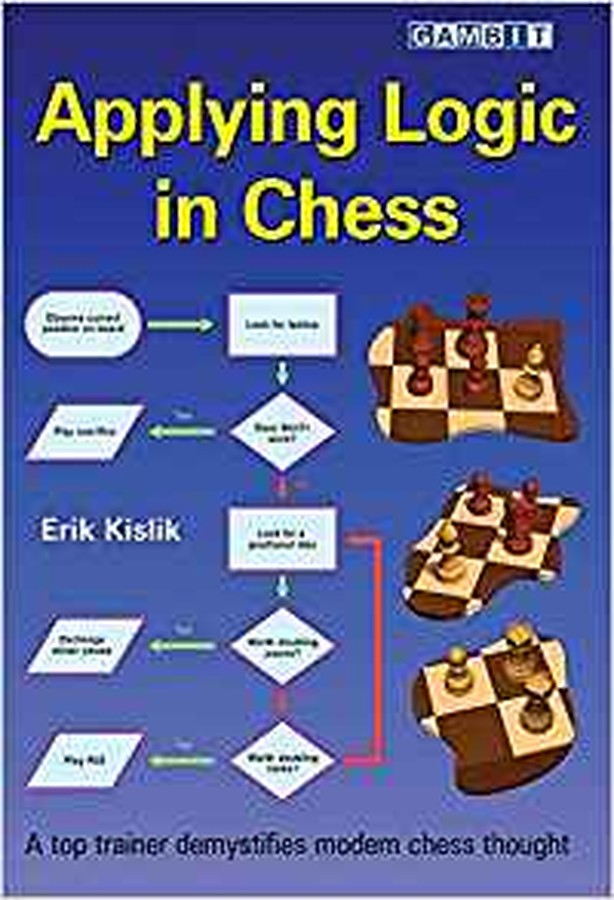| Nivå | C-D |
| Utgivelsesdato | Mai 2018 |
| Forfatter | |
| Pris | 295 NOK |
Applying Logic in Chess
A top trainer demystifies modern chess thoughtEn stor og imponerende bok som besvarer det klassiske spørsmålet: Hvordan bli god i sjakk? Her er både mye refleksjon, treningsråd med litteraturtips og praktiske sjakkeksempler. Glimrende også for sjakktrenere og studenter opp i mesterklassen.
På mange måter er dette blant annet en slik skikkelig "treningsguide" som mange har etterlyst! Her er mye tekst, men også glimrende sjakkeksempler fra en erfaren trenerkapasitet.
Se innholdsfortegnelsen lenger nede for å få et bedre inntrykk av hva denne boka dekker. Nivåmessig er den relevant for alle som har på plass det grunnleggende i sjakk - for eksempel Sjakkskolen 1, 2 og 3 og fortrinnsvis litt til - og deretter er motivert for å jobbe seg videre.
Forfatteren har trenererfaring fra klubbnivå til spillere som har blitt stormestere, og tankene og innholdet i boka forholder seg til denne brede erfaringen. Leseren bør være en spiller eller trener med ratingnivå i sjakk fra cirka 1300 og gjerne godt opp i mesterklassen.
Forlagets omtale:
Is chess a logical game? What constitutes an advantage in chess? How can we set problems and create psychologically difficult situations for the opponent? These are big questions, and Erik Kislik tackles them and others head-on in this thought-provoking, thoroughly modern, and original work.
He answers the first of those questions with a resounding ‘yes!’. His assessments focus on concrete points: pawn-structure, material imbalance and compensation. Even though the analytical proofs may be complex, he repeatedly shows that these elements are the keys to evaluating positions and forming plans.
As the trainer of players ranging from high-level grandmasters to average club-players, Kislik is very strong on providing practical guidance on topics such as how best to use chess software, choosing hardware, getting psychologically ready for a game and preparing for specific opponents. He is always willing to boldly state his views, even when they run contrary to conventional chess wisdom.
“I was excited by this book because of the way all of the ideas are intertwined and you get very concrete advice ... Everything is applicable and it is easy to see how it applies to the real world. ” – from the Foreword by GM Hjörvar Steinn Gretarsson.
INNHOLDSFORTEGNELSEN:
Foreword by GM Hjörvar Steinn Gretarsson 6 Introduction 8
1 Starting from the Beginning 14 Piece Values 14 Interpreting Chess Rules and Ideas Taught to Beginners 26 The Allure of Genius and Glamorizing the Past (Tal Syndrome) 40 What Should You Be Trying to Do When You Play Chess? 44 What Should You Ask Yourself During a Game? 45
2 Levels of Chess Skill 51 What are the Main Stages of Chess Improvement? 51 General Improvement 59
3 Prioritizing Your Chess Undertakings 66 Playing 66 Analysis of Your Games 69 Training 70
4 Elements of Chess Strength 84 Concrete Knowledge 85 Pattern Recognition 85 Calculation 87 Candidate Moves 91 Positional Understanding 102 Logic 103
5 Different Types of Training 106 Tactics 106 Endgames 107 Historical Games and Keeping Up with Chess ‘Culture’ 117 Blitz 120 Books 122 Analysing and the ‘Most Obvious Move’ Principle 128 What Should I Walk Away from My Games With? 131 What Should I Use a Coach For? 131
6 An Approach to Evaluating Positions 137 What is an Advantage? 137 Advantages for Free 149 Conditional Equality 154 Compensation and Complicated Cases 160
7 Is Chess a Logical Game? 176
8 Engines in Chess 182 Analysing Positions with Computers 194
9 Analysing Your Games and Self-Improvement 200
10 Metagame Opening Strategy 225 Metagame Thought 225 Planning an Opening Repertoire 233 Opening Questions to Ask 250 Structures and Openings 253
11 Losing Consistency 269
12 Critical Moments 284
13 Sports Psychology in Chess 295
14 Theory in Practice 307
Conclusions and Recommendations 315 Index of Names 318 4 A PPLYING L OGIC IN C HESS
| Innbundet? | Nei |
| Type | Bok |
| Språk | Engelsk |
| Antall sider | 319 |

